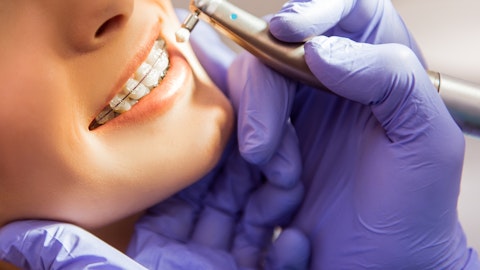Stanley Bergman : Thank you, Elizabeth. Again also two very, very good questions. So let me just provide one more time the context which, I think, we tried to communicate our prepared remarks. So we experienced the cybersecurity incident, we got suspicious. And what we did was — and our CTO made a brilliant move, he brought the whole system down immediately. He knew — he was quite comfortable that our backups were good. So our backups have turned out to be very good. And what we need to do now is turn on application by application. Before you can turn on that application, you have to do certain forensic work to make sure that there are no sleepers in there. And so that’s what we’ve been doing. I would say that at the moment, other than the website, we’re more or less back to where we were.
There are a few areas that require additional turning on, some involving invoicing, some involving the returns function. And the only area we can’t really supply right now because we’re super cautious is on controlled drugs, although we have an affiliate that was not impacted and they are shipping controlled drugs if need be. We expect all of these areas, and this is expect, to be up and running this week. There are some isolated areas where we have challenges. I would say they have less to do with the customer side. We have some parts of the world where we have WMS systems that are not fully functional yet. It’s not impacting the customer because the E3 system, the basic buying system is working, has been working for a while. But it’s just taking us a lot more human capital, human resources in receiving the products, putting them away, and picking.
Those areas will come back, I think, in the next few weeks. So I think from a customer point of view, we’re in pretty reasonable shape today. Yeah, if a customer has an inquiry on certain purchases made some time ago, we may not be able to give an instant response. We may have to do some research through the backups. But in general, operationally, actually we were doing quite well a couple of days after — two days after the cyber incident. The key here is to remember that our backups are in pretty good shape, and we feel very confident in the way we’re bringing up these systems one at a time. Our team on the IT side is remarkable, our investor — our consults are just the best. And we feel pretty good that we are bringing up systems that are stable, and we just have to go through the cycle.
But I don’t think we’re talking about that long. But I’m not sure — but I’m quite sure that from a customer point of view, other than the items I mentioned, we’ll be in pretty good shape tomorrow hopefully when the website comes up.
Ron South : Elizabeth, I’ll take the second half of your question. I believe you were asking if in 2024, did I anticipate we would be accelerating any cost cuts. Did I understand you properly?
Elizabeth Anderson : Yeah. That’s what I was asking. Thank you.
Ron South : Yeah. I think that we will really go about our business in 2024 as we had originally planned. As we said on the call, we have $1 billion committed to acquisitions, and typically in the year — in the short-term following acquisitions, we look for synergy opportunities. Some of those acquisitions will stand alone as businesses, but others do provide us with some synergy opportunities that we’ll be able to implement over the course of ’24 and then just any other normal process that we would go through to identify cost efficiency. So I don’t think this — in the context of the cybersecurity incident, do we feel a need to go out and accelerate any type of cost savings in ’24?
Elizabeth Anderson : Got it, thanks so much.
Ron South : You’re welcome.
Operator: The next question comes from the line of Jeff Johnson with Baird. Please proceed with your question.
Jeff Johnson : Thank you. Good morning, guys. Can you hear me okay?
Stanley Bergman : Yeah, Jeff.
Jeff Johnson : Great. Thanks for taking the call so are the questions. So let me ask two questions. I guess they’re both kind of intertwined, but just so kind of we level set all of us on how to conceptually think about your outlook from here. First, if we could just ignore the cyber for a second, and I’m sure that’s not possible, and that will be my follow-up question. But if we ignore that for a second. Third quarter dental organic growth, right around flattish levels on a global basis, the company-wide 1%-ish. Would those — if you were counseling us on how to think about kind of our 2024 models, would those be starting off points that you would recommend we think about conceptually and where we build kind of our organic ex cyber kind of growth rates into next year?
Stanley Bergman : So Jeff, obviously, we’ve provided a lot of thoughts around this, as have analysts and as the industry. So in broad terms, we believe our business is relatively recession-resilient. It goes down a bit, it will come back. Our North American dental consumable business, as you correctly point out, had flat internal growth. We saw moderate softness in patient traffic in North America due to appointment cancellations, mostly in September. It’s hard to tell how long that has continued. It was similar in the first two weeks of October. But thereafter, obviously, because of the cyber incident, it’s hard to project. If you look at — I’m talking about North America now, sales of traditional dental equipment have been largely reverted to the pre-pandemic levels.


